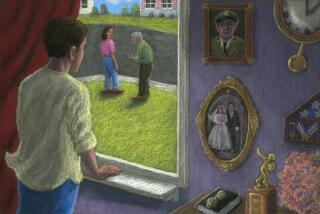Within the Marriage, a Secret Life : A CURE FOR DREAMS, <i> By Kaye Gibbons (Algonquin Books of Chapel Hill: $14.95; 171 pp.)</i>
I keep a small stack of books on my desk as a reference library, not for definitions or etymologies but for evidence that the English language may be, in the service of fiction, ever refreshed and enlivened. âA Cure for Dreamsâ is going into that stack. Full of unforgettable scenes and observations, characters drawn surely and sharply, and writing that is both lyrical and lightning-keen, this is a novel of vision and grace. It shines.
The story of four generations of women, Kaye Gibbonsâ third novel is, however, not a saga, for the telling is economical and quick, the generations conflated. A preface by the youngest, Polly Randolph, suggests the importance of oral narrative as binding force. She heard these things, Polly says, from her mother, Betty, during the Depression in rural Virginia:
âI had spent my life listening to her, sometimes all day, which often was my pleasure during snow and long rains. I would need only say to her: Tell me about your mother and you, and Kentucky and Virginia and the wild way I was born. Tell me about the years that made you. Then she would talk. Talking was my motherâs life.â
And the novel sounds spoken, its language often stranger and stronger than literary language. Kaye Gibbons invents a style both simple and baroque, plain but often startling in its unanticipated turns, its comic cunning. âA Cure for Dreamsâ deserves to be read aloud.
Betty is the main narrator, but her mother, Lottie, also speaks, and her grandmother, Bridget, looms in the background as founder of the line, its first American, who refused to learn more than the basics of English. âShe had brought her family all the way from Galway,â says Lottie, âto hop in the melting pot and then she refused to melt. This is how stubborn my mother was, and this is also more than likely what gave her the oomph to load everybody up and haul them across the ocean in lieu of starvation in Galway.â
Stubbornness and oomph, as well as youthful looks and no small degree of wiliness, are the family traits of these women. Bridgetâs lack of English is more than made up for by her descendants, for whom language becomes a method of survival, a cure for the dream of love. They learn early to protect against that dream. As a girl, Lottie (âfifteen and therefore a slave to riskâ) imagines a horseman who declares himself smitten by her beauty. But then he rides away. âShe never let herself dream the story any other way. Even in her dreams my mother denied herself the impossible.â
Lottieâs memories of childhood include her fatherâs drunken rages and demands. She âwoke up every morning to the sound of him yelling for one of his daughters to cook him an egg. Heâd stand in the kitchen and shout at the ceiling, Come cook me a goddamn egg!â His brother would join him, and heâd shout, âCook Bart a goddamn egg too!â after which âboth men would eat their eggs and take to smacking liquor and talking loud-mouthed. The daughters had a very difficult time keeping these men wetted down.â
The men in âA Cure for Dreamsâ are not a benevolent or sensitive lot. Bettyâs father, Charles, is obsessed by work and money. Lottie married him âfor love and rest,â but got neither. Charles expected her to work in the fields, forgo pleasure, postpone having children. She thought of going back home, but recalling the strife between her own parents, she says, âI decided to stay with Charles and see what would happen to me, and until I understood that I had a hand in making whatever happened happen, I was a very sad young girl.â
When Betty is born, Lottie gains an ally. From the beginning, Betty understands the alliance with her mother as a conspiracy: Lottie is shaping a secret life within the marriage, and her daughter is her accomplice. âHer intent, in fact, was to leave him without leaving him,â Betty realizes.
Mother and daughter seek their pleasures clandestinely, deceiving Charles as to the price of fabrics, spending their days with neighboring women, building a life of delights separate from and unknown to the men. Their entourage includes Polly Deal, the black cook-laundress-midwife-doctor, and Trudy Woodlief, a scrabbling newcomer with âenough kids to bait a trotline,â all of whom she trains to steal from the grocer. Lottie becomes a leader and something of a savior for this community of women, while Betty watches and learns.
It is one of the remarkable accomplishments of âA Cure for Dreamsâ that the heroism of its women and the shortcomings of its men do not seem exaggerated. With a delicate hand, Kaye Gibbons reveals how the menâs ways, accepted as commonplace, require courage of the women. Having organized a group for card-playing in the back room of the grocery store, Lottie teaches Betty to recognize which women are âloved rightâ:
âListen and hear what the men call their wives when they come to the store to fetch them. Listen. Old Squaw. This sounds bad but itâs truly sweet. Dear and Honey. I wouldnât trust these. They have an unnatural ring. No name, just Come on! This is what your father says, so that should tell you something. And this is what Roy Duplin says calling for Sade, and you know how nasty this sounds.
âWatch Sadeâs shoulders hop the next time he yells for her. . . . Rarely, rarely will you hear a woman called from the store by her name, which is best. So listen for each time Richard Bethune comes to the door and calls, Amanda! so nicely. And watch how she gladly goes to him. A womanâs name will always suffice, but if youâll keep your ears open in a room with men and women, youâll hear itâs the call used least often.â
Betty watches her mother become the âQueen Beeâ of Milk Farm Road, âmore or less organizing life through knowing everything.â With her sharp eye for detail, Lottie discovers who killed Sade Duplinâs husband, and she sees immediately that something is amiss with Bettyâs first young man. For Lottie, life is enriched by watching, listening, talking--knitting herself into the community--while her husband becomes more and more isolated by greed and fear. When he dies, self-drowned, no one grieves.
With this unpromising experience of men (her father and grandfather both more or less horrendous and her male contemporaries uninteresting or unreliable), Bettyâs prospects for love might seem small. In fact, however, in this always surprising novel there are frequent âturns in the road,â as Betty calls them.
The dream she has never allowed herself is one that may come despite precautions, and the novel culminates in a scene of hope and wonder, amid the continuing voices of wise women.
More to Read
Sign up for our Book Club newsletter
Get the latest news, events and more from the Los Angeles Times Book Club, and help us get L.A. reading and talking.
You may occasionally receive promotional content from the Los Angeles Times.








